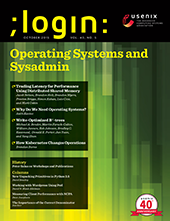USENIX supports diversity, equity, and inclusion and condemns hate and discrimination.
It’s Time to End Monolithic Apps for Connected Devices
;login: Enters a New Phase of Its Evolution
For over 20 years, ;login: has been a print magazine with a digital version; in the two decades previous, it was USENIX’s newsletter, UNIX News. Since its inception 45 years ago, it has served as a medium through which the USENIX community learns about useful tools, research, and events from one another. Beginning in 2021, ;login: will no longer be the formally published print magazine as we’ve known it most recently, but rather reimagined as a digital publication with increased opportunities for interactivity among authors and readers.
Since USENIX became an open access publisher of papers in 2008, ;login: has remained our only content behind a membership paywall. In keeping with our commitment to open access, all ;login: content will be open to everyone when we make this change. However, only USENIX members at the sustainer level or higher, as well as student members, will have exclusive access to the interactivity options. Rik Farrow, the current editor of the magazine, will continue to provide leadership for the overall content offered in ;login:, which will be released via our website on a regular basis throughout the year.
As we plan to launch this new format, we are forming an editorial committee of volunteers from throughout the USENIX community to curate content, meaning that this will be a formally peer-reviewed publication. This new model will increase opportunities for the community to contribute to ;login: and engage with its content. In addition to written articles, we are open to other ideas of what you might want to experience.

The proliferation of connected sensing devices (or Internet of Things) can in theory enable a range of "smart" applications that make rich inferences about users and their environment. But in practice, developing such applications today is arduous because they are constructed as monolithic silos, tightly coupled to sensing devices, and must implement all data sensing and inference logic, even as devices move or are temporarily disconnected. We present Beam, a framework and runtime for distributed inference-driven applications that breaks down application silos by decoupling their inference logic from other functionality. It simplifies applications by letting them specify "what should be sensed or inferred," without worrying about "how it is sensed or inferred." We discuss the challenges and opportunities in building such an inference framework.

